The Secret of Honey
simple stars & petal confetti
But heaven and earth was teeming around them, and how should this cease?
D H Lawrence, The Rainbow
Wild rose along the lane, June 2023.
Hello friends, and a happy new moon in Gemini! I hope this finds you peaceful and at ease with the season.
An Evening Walk
An evening walk along the lane to gather bracken for my hearths. Catching the last rays of the sun which has shone all day through a clear blue sky. The first thing that hits me is the scent. The air may have cooled, the breeze almost fresh, but the perfumes have been gathering in the drowsy warmth. Now they spread, treacle-like, through the early evening, filling my nostrils and every pore.
Elder, woodbine, these tumble around me. The blackberry flowers are just beginning to open, white and starry. I must bury my nose next time and see if these are scented too. The wild roses, yes. Their petals are already softening the edges of the lane. Pale pink hearts, scattered like confetti and bringing my own heart up with a jolt.
Suddenly, what looks at first glance to be a long-legged cat trots across the lane, drawing my eye. It’s quite distant but unmistakably a tiny baby muntjac, and indescribably cute. A moment later mama emerges from the woodland and quickens her pace to keep close to her young one.
Bracken gathered, I turn and almost gasp as an enormous dragonfly crosses the lane, then criss-crosses again in figures-of-eight, darting and dancing. It’s soon joined by a second one, and I can see all four wings of each dragonfly silhouetted against the growing dusk, vibrating hard. Their speed is dizzying, exhilarating.
The evening scent has, I realise, a base note of hot tarmac and I wonder if it’s the residual warmth that has attracted the dragonflies. Or, rather, the tiny insects that the dragonflies must be hunting. My very first sighting of the year and as exciting as the first cuckoo call.
Swathes of dog daisies bob on the bank and where have they sprung from? The season is moving on. Long bunches of keys festoon the sycamore, and there are even tiny conker cases on the tall horse chestnut, almost as cute as the tiny muntjac. Almost.
Small movements in the lavender.
Bees about their business:
the secret of honey
that they keep to themselves.
Where my favourite boulder
has slipped a little further
into the river -
new washed moss
and all the hidden creatures
beneath, plunged deeper,
breathing dissolved air.
Walking at night
in summer under the trees
smothered in darkness
while an owl cries
sharp and softly
from its fortress of leaves.
The pressure of your arm
around my waist:
the road ahead invisible,
the scent of flowers arriving
from an unknown place.
Hilary Llewellyn-Williams, Secret, from Compline in The Little Hours
Early morning foxgloves in Acorn Wood, June 2023.
Lady’s Bedstraw
The atmosphere of Norfolk’s hidden corners and ancient places has called to me since I was a child. I love that the magic here is quietly present in our dappled woodlands, gorse topped heaths, shifting shorelines and the inky depths of the reed-fringed Broads.
There are no stone circles or prehistoric chambered tombs but still, without fuss or pomp, the land here holds and remembers the sacred places of old. On Salthouse Heath, veiled with heather, birch and gorse, at least 35 Bronze Age burial mounds hold the remains of people who walked these ways thousands of years ago, treading into the very paths and tracks their hopes, fears, joys and memories.
This is Sea Palling churchyard, undisturbed through our own disturbed and disturbing times. How very beautiful are the wild flowers swaying here. I sit reflecting on all of this and revelling in the lady’s bedstraw rampaging over the graves. Now here is a herb with a wealth of magical legend and folklore attached to it, and its roots yield a glorious red dye.
One story has it that the Virgin Mary lay on a mattress of bedstraw to give birth. When it bloomed to welcome the baby Jesus, its white flowers turned to gold.
Sea Palling churchyard adorned with lady’s bedstraw.
The Cliff Top
The kestrel will tell you: you get a different perspective from the cliff top. It’s one thing being down on the shoreline, feeling the push/pull of lace-edged wavelets and hearing their sighs as they lap around your feet. Another time you’ll find yourself having to stand your ground against the wind as giant waves roll and crash, their undersides silky as molten chocolate. But on the cliff top, well, you’re up there with the birds.
High above it all, you can’t take your eyes off the horizon. The depth of hue and the exquisite slivers of light that play along it. But you pull your gaze to the middle ground where the wrinkled waves sparkle in rainbow hues and cormorants alternately skim the surface and sit on weathered sea-groynes, stretching out their wings to dry in the sun.
Gulls swoop with ease between the worlds, seemingly content to watch from the grassy edge until a sudden clap of wings and they’re off, launching themselves onto the thermals. I wonder how it feels to be free as air, delicately twisting to catch the currents? Like the sea that they circle, their colours shift endlessly with the movement of the clouds, silver against pewter, onyx against opal.
But it’s the sunrises, sunsets and the full of the moon that mesmerise.
On this part of the north-east Norfolk coast, the sun rises directly out of the sea. And it’s from the cliff top that you get your very first glimpse as it rests its fingertips on the rim of our curved earth and gently hoists itself over the edge. It’s lovely to be down on the beach, basking in the rose-gold path of the sun as it lifts and warms, but it’s from the cliff top that we first catch the red pin-prick of promise that the light will return, as it does every day.
Solstice sunrise at around 4.30am, 21 June 2022, Happisburgh, Norfolk.
Sunsets, here, are different. This far around the coast you will never see the sun set over the sea, but to be on the beach at the right time to witness the reflected light that sometimes, with sudden grace, turns the sky and sea to pink, turquoise and palest lavender is to witness beauty indeed.
As the sun drops down behind the cliff and the light show fades, you climb up the oft-cut path onto the top again. As you step onto the clover, plantain and ragwort the orange tracery of the sun’s last rays illuminate your way once more. Sometimes it’s behind the church tower, sometimes it’s arched just beyond the next fold in the cliffs, according to the part of the Wheel we are riding.
Sunset from the cliff top, June 2022.
As you leave the beach you might think that your breath could not be taken away again until the next time; another day, whenever you’re lucky enough to be in the right place at the right time once more. But you’d be wrong. It was there for you all along and you just had to climb a little higher to stand witness to that extra moment of beauty.
Did I mention the rising of the full moon over the sea? There’s an alchemy in watching its silvery path ripple over the brine where at sunrise, a golden trackway will open up to greet the new day.
The full moon’s silvery path, Happisburgh.
A Year Ago Today - Visiting the Wild Woman of Ludham
The wild woman of Ludham: unique in the UK as the only carving of a female woodwose.
The Norfolk village of Ludham is heavy with enchantment, populated as it is by many magical beings, notably the legendary Ludham Wyrm (dragon).
The church font is encircled not only by dreamlike flying beast-humans and smiling lions but, on either side, a wild man and a wild woman.
Male woodwoses are quite a common motif in Norfolk church stone carving. Sometimes they’re a play on the name of a grand local family like the Woodhouses (woodwoses - sort of!) and that makes sense, but often their presence is explained as a representation of the forces of wild nature, like green men.
Quite honestly I don’t think that anyone has put forward a truly convincing argument for what green men are doing in a church. Yes, some of them look somewhat tortured with foliage spewing uncomfortably from their orifices but others look calm and happy, even beatific. Maybe there just isn’t one simple explanation and it will remain a delicious mystery. It’s unlikely that they were a ‘secret’ symbol of the continuing pagan beliefs of the church builders, situated as they often are in prominent parts of the church, sometimes even adorning the row of priests’ seats (sedilia) close to the altar.
Another theory is that they are a Saxon snub to the Normans. After the Battle of Hastings in 1066, a guerrilla movement continued to resist the Norman conquerers. The Normans termed them the silvatici, the men of the woods. The English, it is said, called them the same thing in their own language, making them ‘green men’.
But back to our lovely wild woman. Information next to the font tells us that although female woodwoses are sometimes found on medieval tapestries and stained glass, this carved Ludham wild woman is unique in this country. The panel goes on to point out that while her male counterpart on the other side of the font carries a club in one hand and a shield in the other, the female woodwose carries only a club.
I could see something under her other hand but it was hard to make out until I looked at my photos. That’s when I discovered our wild woman is actually a Sheela-na-gig!
Sheela-na-gig stone carving from Kilpeck church, Herefordshire.
All the sun long it was running, it was lovely, the hay
Fields high as the house, the tunes from the chimneys, it was air
And playing, lovely and watery
And fire green as grass.
And nightly under the simple stars
As I rode to sleep the owls were bearing the farm away,
All the moon long I heard, blessed among stables, the nightjars
Flying with the ricks, and the horses
Flashing into the dark.
Dylan Thomas, from Fern Hill
The Fires of Midsummer
My Sea Charm candles; the fires of midsummer. Twin fires to purify, fire as a plea to the sun to keep giving its life-giving rays, a beacon to light the dark half of the year.
The walk started in the south porch of the church and, after a dizzying loop of midsummer abundance, finished in the porch on the wild north side, the ancient flint building itself acting as a battery to complete the circuit. Outside the consecrated ground I lit a fire on the very edge between the holy and the holy, and spoke of the thin membrane between the worlds at this pivotal point of the year. Cleansing smoke spiralled; mugwort, St John’s wort, chamomile. Tales of the fair folk and the old magics, before we passed around fairy cakes decked with wild rose petals, and an experimental alcoholic lemonade. Swedish of course. If anyone knows how to celebrate midsummer with a full heart it’s the people of the Northlands.
As the fire burned low, participants (including a journalist from the local press) were invited to jump the embers for abundance and well-being during the coming year.
Write-up in the Eastern Daily Press.
Everyone knows about the midsummer fires for the Solstice or Midsummer’s Eve (St John’s Eve, 23 June) but until I started researching medieval festivals I hadn’t realised there had been (a magical) THREE saints’ days when bonfires and feasting had been the custom. As well as for St John, fires were lit for St Peter and St Paul on 29 June and for St Thomas on 3 July. Can it be a coincidence that these all took place around midsummer?
For our guided walk, we had chosen a Saturday close to midsummer. It was only afterwards that I realised it happened to be 29 June, St Peter and St Paul’s Day. Later still I remembered that the medieval church is itself dedicated to St Peter and St Paul. Another coincidence .... maybe.
And who knows what residue of that golden afternoon lies within this raggedy corner outside the church wall, bursting with buttercups, red campion and swaying plantain, alive with grasshoppers?
Midsummer fire: telling tales of this tide in the wild margins beyond the churchyard, church of St Peter and St Paul, Salle, Norfolk.
Henbane
The approach of the Summer Solstice always makes me think of henbane, Once upon a time, I hankered for henbane in my garden. I’ve always had a fascination with plants that have a magical or sinister reputation, and for some reason I was suddenly desperate for some henbane seeds.
It was probably mid June, and I tried googling to see if I could find a herb seed supplier who listed henbane in their catalogue. I discovered a cottage garden seed company who were actually based here in Norfolk, albeit in a distant western fen-edge village I had never visited. Although I thought of the species as a deliciously scary enchanter’s herb, apparently it’s also a desirable annual cottage garden plant.
I think I must have tried ordering, but then had a message from the business owner, Jane, apologising that the seed was out of stock and the season so far advanced that she would not have any more until the autumn.
I must have sounded disappointed, as indeed I was. And then something surprising happened. Jane told me that it was soon to be her birthday and it was a special birthday so she was having a party on the Midsummer Solstice. Would my husband and I like to come along? Her own cottage garden was full of self-sown henbane seedlings and she would be happy to dig some up for me to take home.
Reader, the answer was yes please! So it was that we set out to a birthday party in the home of someone we had never met, taking place in a village we had never visited. It was a beautiful Solstice evening and Jane’s garden was fragrant and full of the beauty of Midsummer. True to her word, she went around the beds with a trowel and presented me with a tray full of tiny, straggling henbane plants for which she would take no payment.
The summer that year was dry, and the little plants did not look happy even as I got them home. Jane had warned me that they didn’t take well to being transplanted. Truth to tell, I felt that if I planted them out to take their chances with everything else they would disappear almost immediately. But they weren’t doing well confined in a tray of earth either.
In the end I decided that there was little to lose by planting them out and they would either survive or they wouldn’t. They were spindly, and losing leaves.
At the time I’d been looking at one of my favourite little books that I’ve mentioned here before. In Garden Spells, Claire Nahmad shares the wisdom of her great-grandmother, a 19th century South Yorkshire wisewoman. I’m fascinated by the use of what she terms ‘runes’ or charms that are said over certain plants or when performing particular actions. These verses do, I know, have a very long history of use. The 11th century edicts of the church fathers, chastising people for chanting charms over herbs but authorising the very same magic as long as it was the Our Father that was being muttered, are proof of that.
I remembered something I’d seen in Claire’s book about avoiding having to uproot an elder tree. If there was absolutely no alternative, the wisewoman said, it should be replanted in a wild place and this charm murmured over it:
From Christ’s sacred heart
Fell three drops of blood
And Mary’s tears
Fell into the mud.
Water, Spirit and Body of Earth
Bless this tree with second birth.
I was interested in this rhyme even when I had no immediate use for it, as I love this kind of Christian magic that was so typical of the cunning folks’ repertoire. And now I thought I knew the very application for it. I carefully planted each ailing henbane scrap between other plants and each day I watered each one while chanting the rune. What harm could it do?
I’d love to be able to say that the plants became huge, bushy, bursting with life and vigour. They never really did catch up. But they survived, and set seed which I kept so I could begin again.
Those seeds stayed with me through challenging times until by rights they were too old to germinate. But here at The Old Shop I sowed some, and a few did emerge. I lost track of most of them, but one day I noticed a distinctive set of leaves thrusting out from the gravel and rubble. Yes, henbane had made a home here. Was its very presence due to the little rhyme I had charmed its ancestor with all those years before? Do let me know if you try this yourself!
Henbane in my garden. Such a presence.
Until next time.
With love, Imogen x


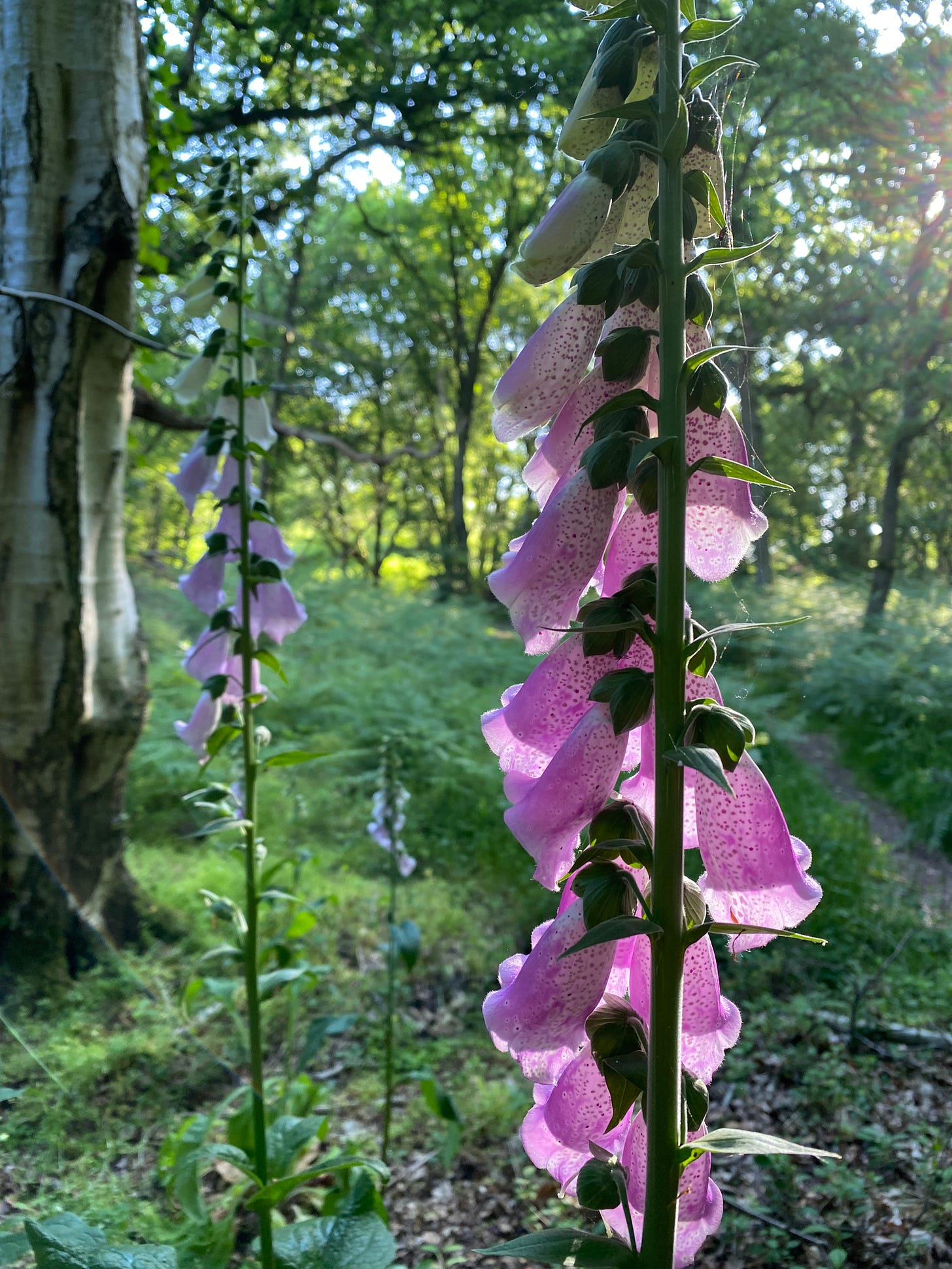
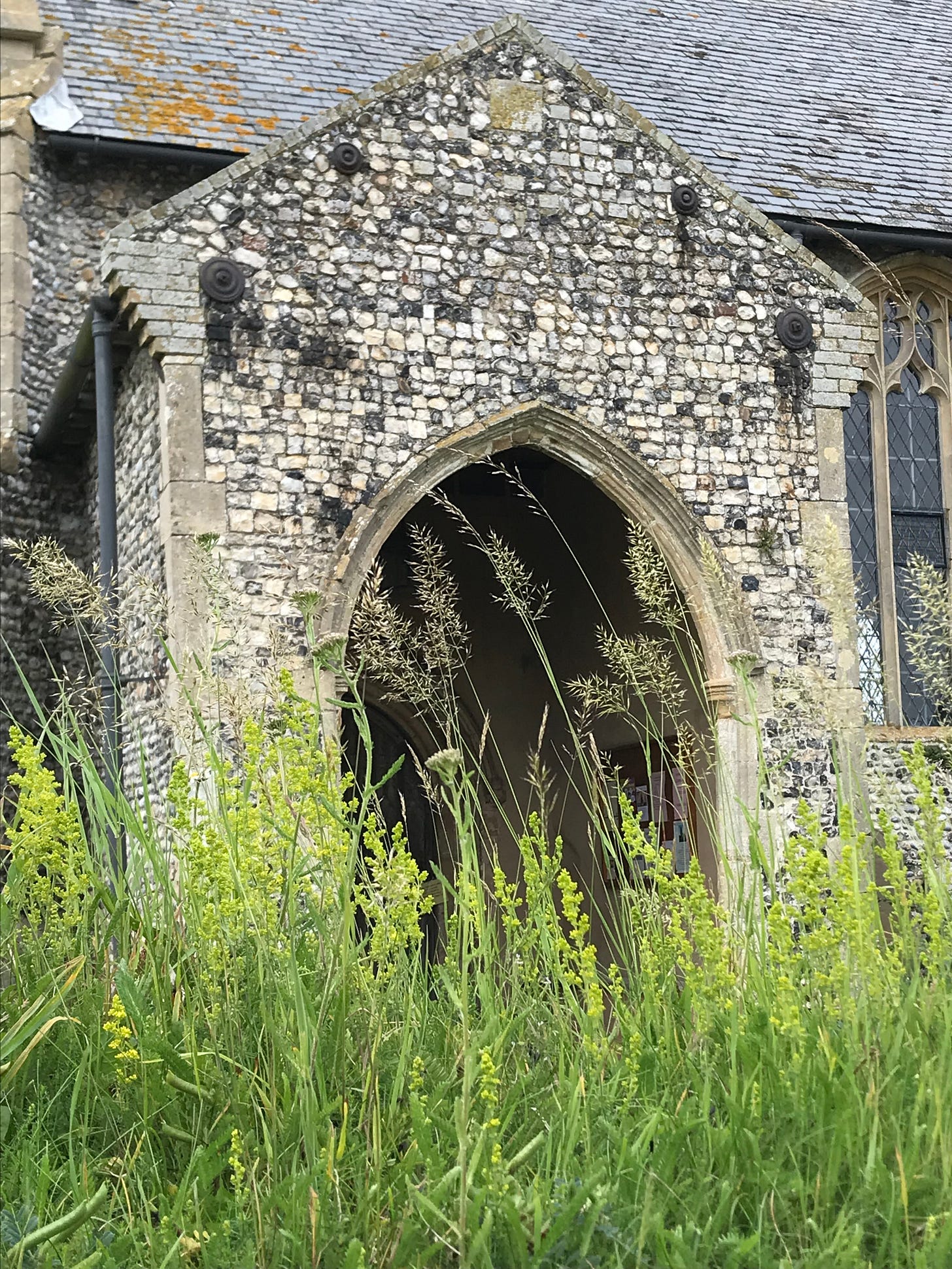
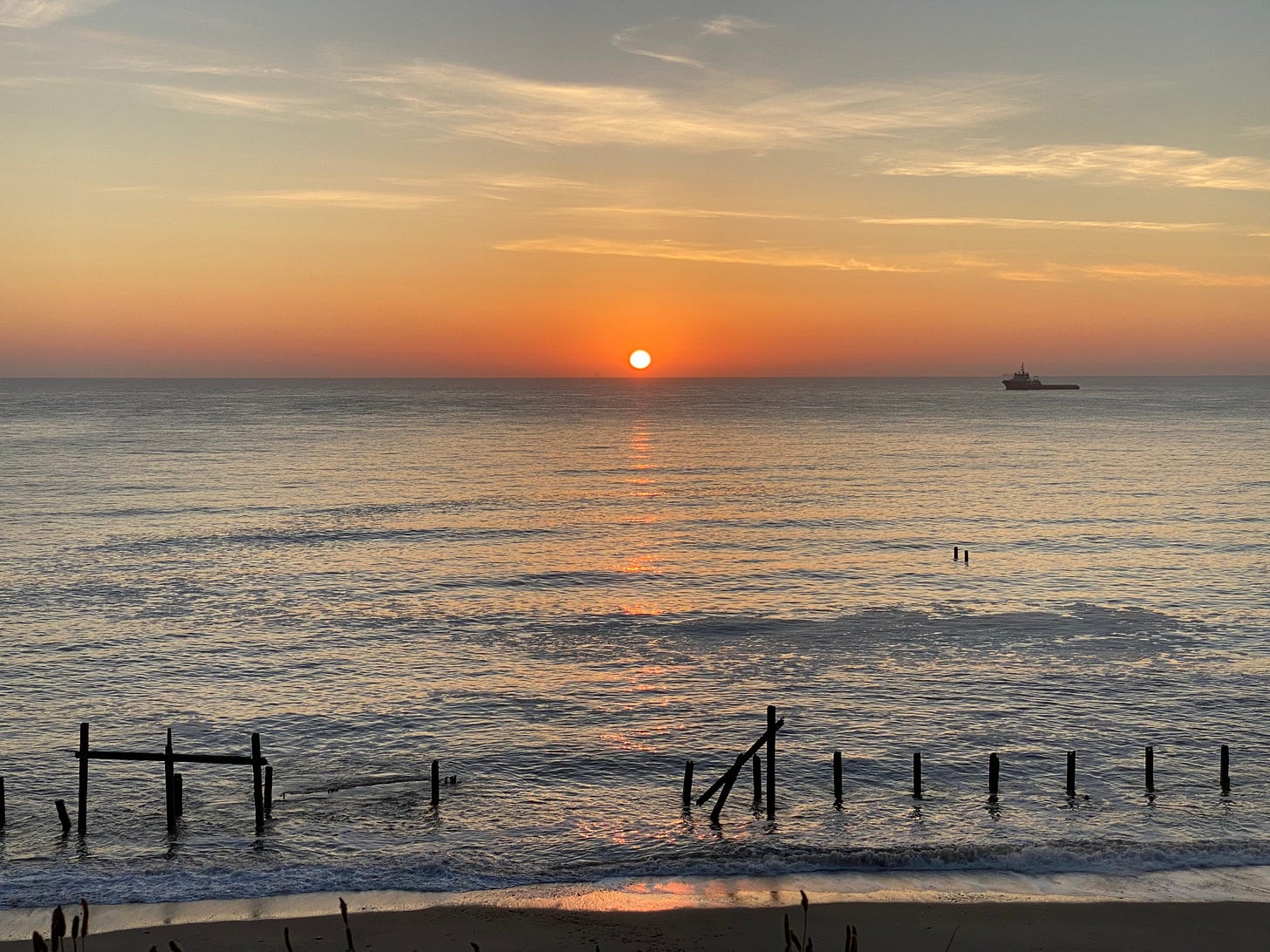
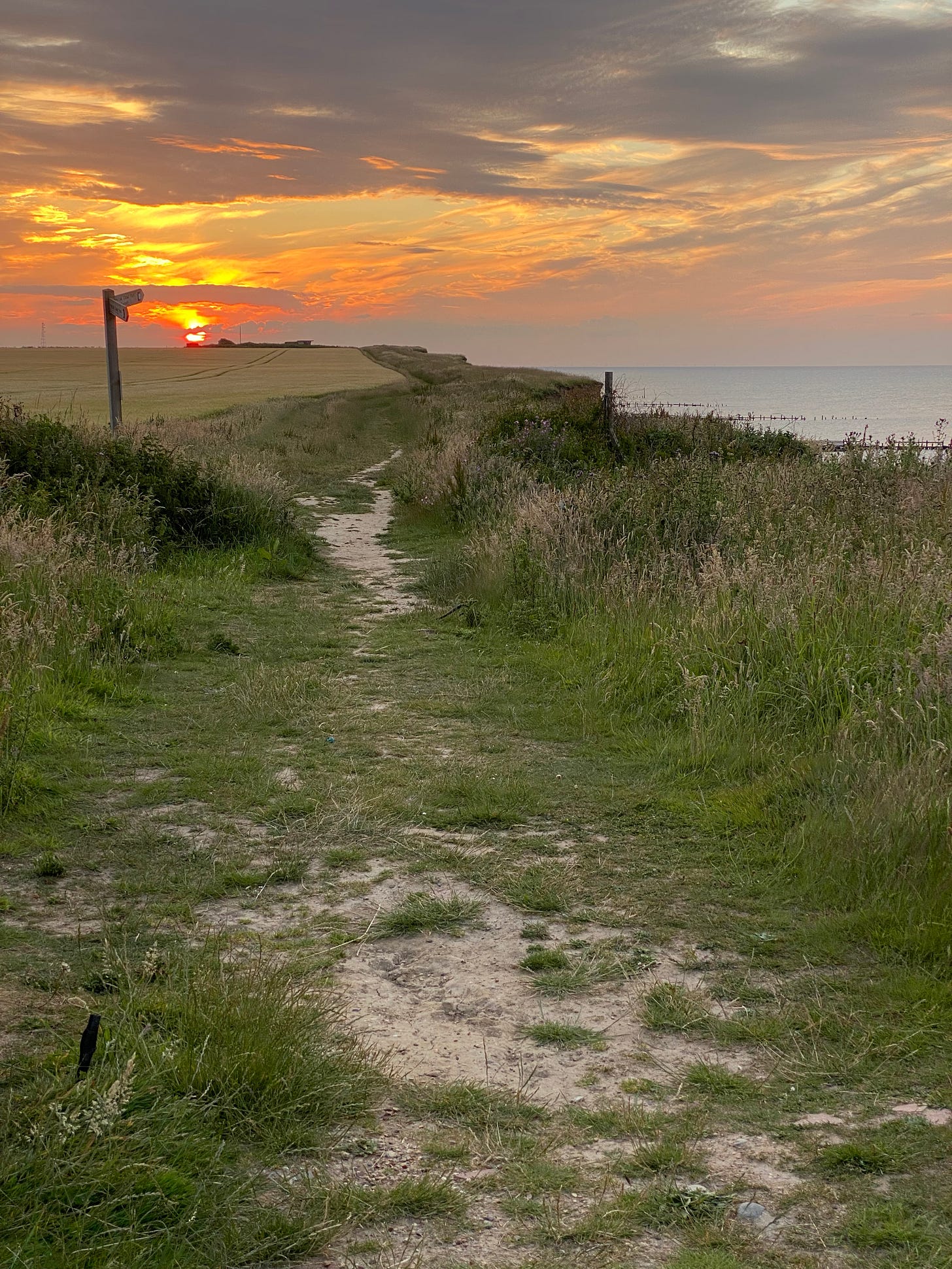
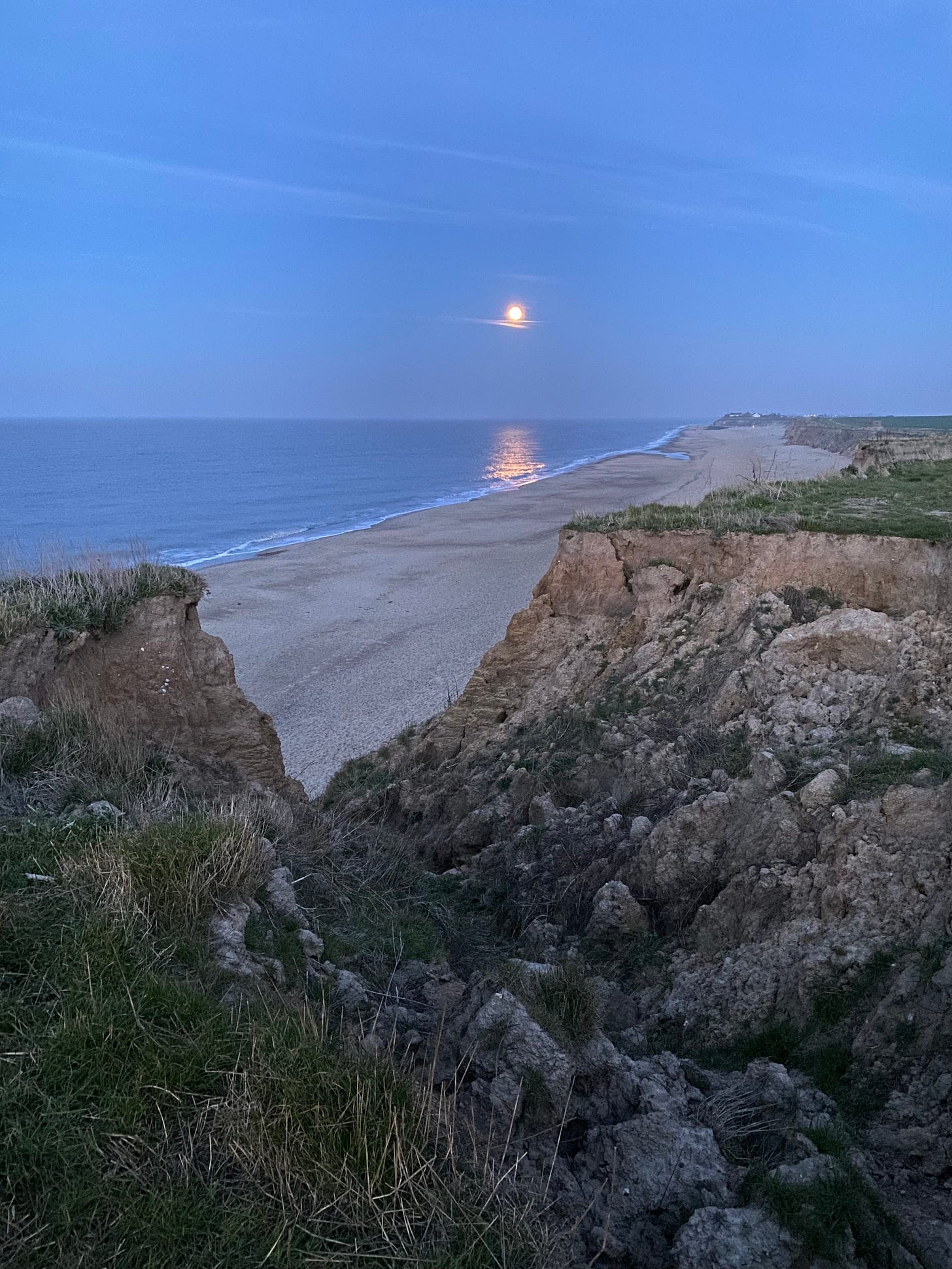



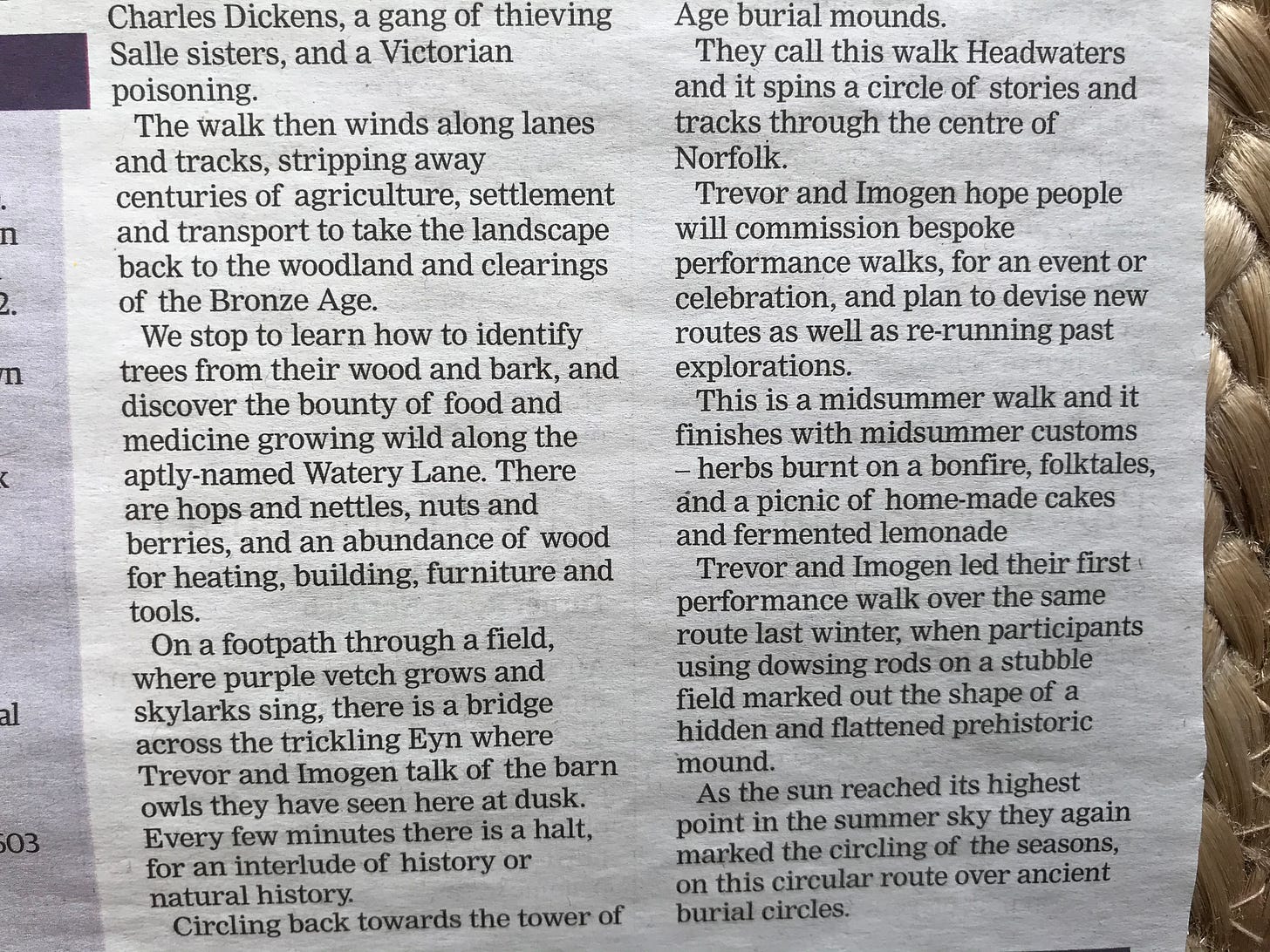

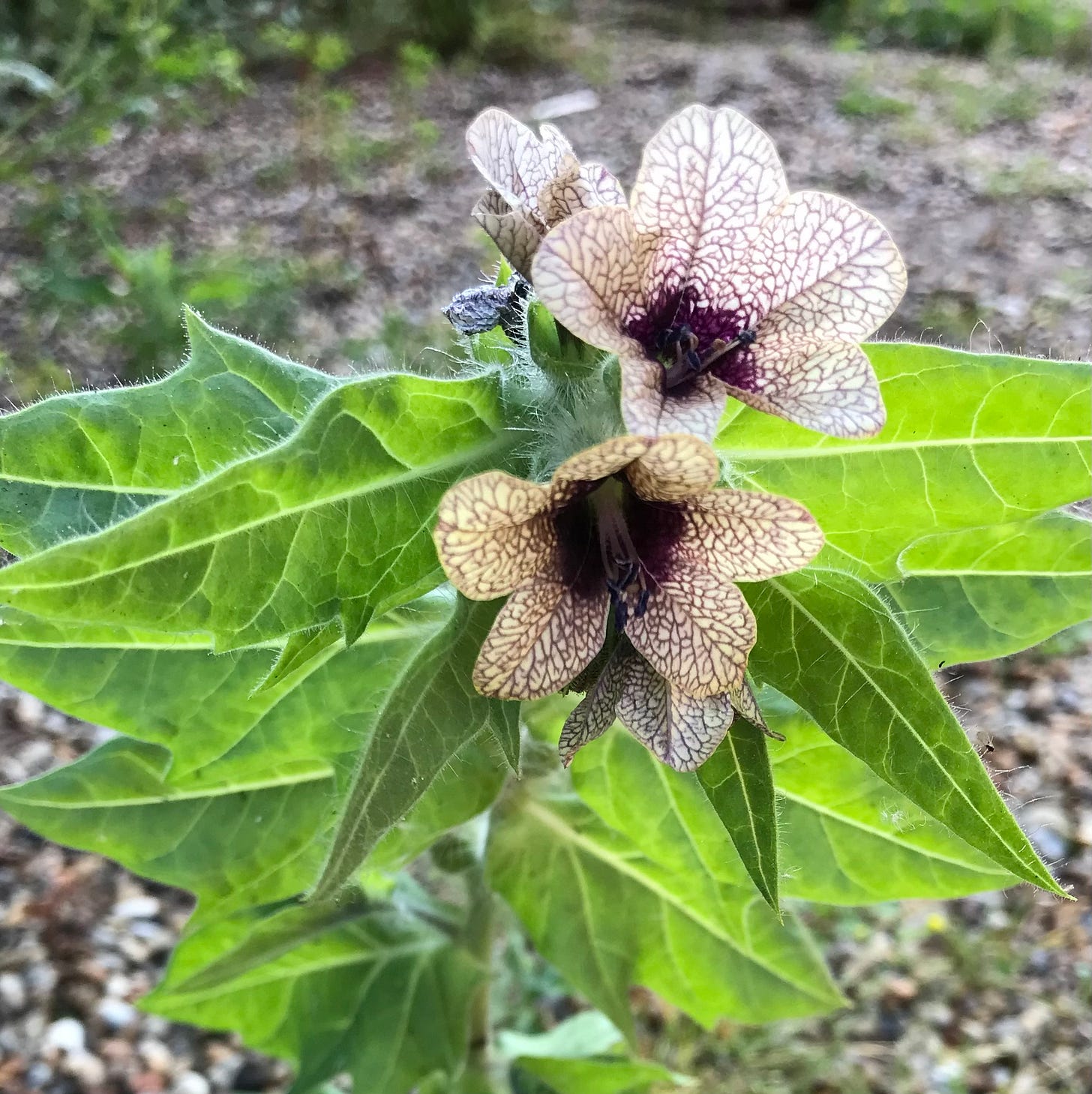
Beautiful lyrical descriptions as usual Imogen and great photographs. You really create the atmosphere of the scenes you describe.
🙏 for sharing your delight and joy you weave such magicks and beautiful blessings with your beautiful words and photos. 💜🌀🧡